As an Amazon Associate I earn from qualifying purchases. Amazon and the Amazon logo are trademarks of Amazon.com, Inc, or its affiliates.
Choosing the ideal scope reticle is always a tricky proposition due to the sheer number of reticle options on the market today. Furthermore, your reticle choices can get even more complicated if you need a more specialized reticle option for a specific type or style of shooting. Recently, a reader contacted me through the website with some questions about the Leupold TMR reticle.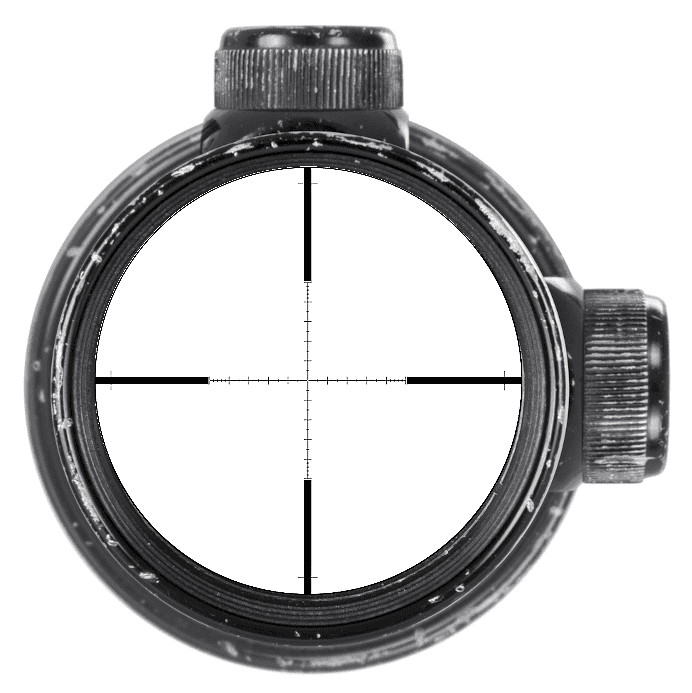 He asked the following:
He asked the following:
“I’ve got my scope choices narrowed down to either a Mark 3HD 8-24×50 SF with the TMR reticle or a VX-3i LRP 8.5-25×50 SF with a TMR reticle. Do you have any experience with either, and what are your thoughts on the TMR reticle compared to a standard mil-dot reticle?”
Since the question really couldn’t be answered in a short format, and since Leupold actually offers (or offered in the correct tense now) more than one version of the TMR reticle, I felt it might make sense to do a more complete write-up to answer the question as accurately as possible.
History and Overview of the TMR Reticle
The Leupold TMR reticle was first introduced in 2011, with the TMR being an acronym for Tactical Milling Reticle. This reticle was designed off the traditional mil-dot reticle with the idea that transitioning from mil-dots over to full and half hash marks would offer the user a more precise ranging and shooting.
The traditional mil-dot configuration features a duplex crosshair style reticle with eight dots mounted on the vertical and horizontal reticle axis, with each dot measuring 025 millimeter in size. With this configuration, each axis on the scope ends up with four dots on each side of the dividing axis.
These mil dots serve two purposes:
- Allow for range estimation to a target
- Used as a compensated aiming for bullet drop and wind drift
Since mil-dots were introduced some time ago, they were initially built for second focal plane scopes, although they can also work with first focal plane models. With the second focal plane scopes, each scope manufacturer has a “true” power magnification setting where the mil-dots are considered to be “true.” The true designation is just a baseline magnification range to use during ranging and bullet holdovers. Most mil-dot scopes use the 10x power as the true setting, but it does vary by manufacturer.
Since mildots were adopted by the US military when first introduced, many people mistakenly believe that the MIL designation in the mil dot name refers to “military.” However, that’s not correct. The MIL designation refers to milliradians, which is an angular unit of measure that equals one yard at 1000 yards and 1 meter at 1000 meters.
The two most common complaints about mil-dot reticles are:
- First, the dot may cover up a tiny target at long distances.
- Shooting situations where the target ends up being located between two mil-dots without a specific hold-over point between the two dots.
Leupold designed the TMR reticle in an attempt to solve these issues. I like to think of the TMR reticle as an improved mildot reticle with no dots to potentially obstruct the view or target coupled with 1 mil and .5 mil hash marks options compared to the 1 mil only option on a mil-dot reticle.
Leupold Offers Six Versions of the TMR Reticle
Something else to be aware of when considering a Leupold scope equipped with one of the TMR reticles is the fact that Leupold actually offered six different variations of the TMR reticle, and each version is slightly different from the original TMR model.
Here’s a quick overview of each variant:
Original TMR Reticle
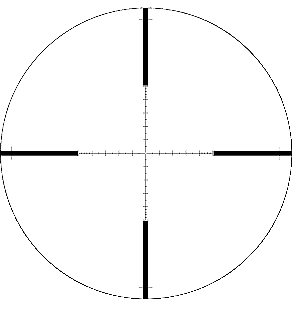 The original version was introduced in 2011 and was simply called the “TMR reticle.” This reticle was offered on several Leupold scope models from 2011 to 2021. This reticle was explicitly designed for use with second focal plane scopes on the highest available magnification power.
The original version was introduced in 2011 and was simply called the “TMR reticle.” This reticle was offered on several Leupold scope models from 2011 to 2021. This reticle was explicitly designed for use with second focal plane scopes on the highest available magnification power.
When the original TMR reticle was introduced, it was predominantly available on the Leupold Mark 4 series of scopes.
At the end of 2022, Leupold phased the original TMR reticle out of their reticle offering, although you can still get one from the Leupold Custom Shop.
TMR (Mark 3HD)
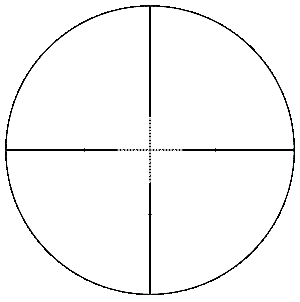 The Mark3 HD version of the TMR reticle was introduced in 2021 and is only available on specific select scope models within the Mark 3 HD line of optics.
The Mark3 HD version of the TMR reticle was introduced in 2021 and is only available on specific select scope models within the Mark 3 HD line of optics.
The Mark 3HD version of this reticle was designed for use with second focal plane (SFP) scopes when used on the highest magnification power of that specific scope.
TMR (MK)
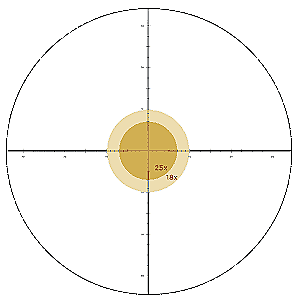 First introduced in 2015, the MK version of the TMR reticle is designed for use on FFP (first focal plane) models only. The hash marks on this version are built at 0.5 mils apart but transition to 0.2 mils on the outer edges of the reticle.
First introduced in 2015, the MK version of the TMR reticle is designed for use on FFP (first focal plane) models only. The hash marks on this version are built at 0.5 mils apart but transition to 0.2 mils on the outer edges of the reticle.
Due to the nature of FFP scopes, this specific version of the TMR reticle has a smaller field of view on the reticle at higher power ranges.
The MK version of the TMR reticle is still available on specific FFP scope models in the following Leupold series:
- Mark 5HD
- Mark 6
- Mark 8
TMR (MK) Illuminated FFP
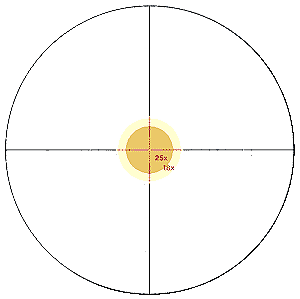 In addition to introducing the non-illuminated version of the MK-based TMR reticle in 2015, Leupold also introduced an illuminated version the same year.
In addition to introducing the non-illuminated version of the MK-based TMR reticle in 2015, Leupold also introduced an illuminated version the same year.
Like the non-illuminated model, the illuminated TMR (MC) reticle is specifically built for use with first focal plane optics.
The illuminated model of the MC-based TMR reticle is only available on specific scope models in the following Leupold scope series:
- Mark 8
- Mark 6
- Mark 5HD
TMR (VX-Freedom)
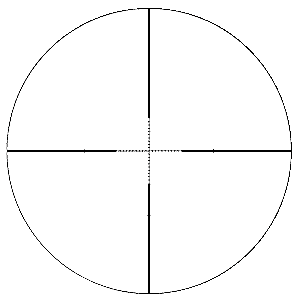 In 2020, Leupold decided to add a version of the TMR reticle to the VX-Freedom AR series of scopes. This variant of the TMR reticle was called the TMR (VX-Freedom) reticle. Note that this version of the TMR reticle was only available on the AR scope models within the VX-Freedom series.
In 2020, Leupold decided to add a version of the TMR reticle to the VX-Freedom AR series of scopes. This variant of the TMR reticle was called the TMR (VX-Freedom) reticle. Note that this version of the TMR reticle was only available on the AR scope models within the VX-Freedom series.
Like most reticles found on the VX-Freedom scopes, the TMR version made for the AR series was designed for second focal plane use only.
At the end of 2022, Leupold opted to remove this variant of the TMR reticle from the reticle options within the VX-Freedom line of scopes.
TMR-D Illuminated FFP
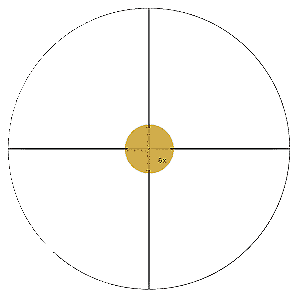 Introduced in 2015, the Leupold TMR-D illuminated FFP reticle was specifically designed for use on the Leupold Mark 6 series of tactical optics.
Introduced in 2015, the Leupold TMR-D illuminated FFP reticle was specifically designed for use on the Leupold Mark 6 series of tactical optics.
This TMR reticle variant is built for use on a first focal plane combat optic where targets range from up close and personal out to distances where you really need to reach out and touch something.
While all the TMR reticle variants are similar, this TMR-D version is the most unique among all six options.
The TMR-D reticle is only available on the Leupold Mark 6 1-6×20 M6C1 Illuminated FFP TMR-D model.
How Are These TMR Reticles Different From Each Other?
Each of the TMR reticle options mentioned above differs slightly from the original TMR reticle introduced in 2011.
For example, some of the TMR reticle variants are explicitly designed for use on second focal plane scopes, while others are geared for use on first focal plane scopes. In addition, the first focal plane models are reticles are different from the second focal models as the FFP reticles change size as the scope magnification power changes.
In addition, some of the TMR reticles are illuminated, while others are non-illuminated. In addition to the traditional illuminated reticle options, Leupold also offers a version of the TMR reticle that is integrated with the Leupold Firedot. The Firedot is another illuminated reticle format where only a small dot in the very center of the reticle is illuminated.
How Does the TMR Reticle Compare to the Standard Mil-Dot Reticle?
The TMR series of reticles offer additional aiming and ranging points compared to the mil dot reticle.
For example, a military-based mil-dot reticle features eight aiming points along each crosshair axis. In comparison, most of the TMR reticle options feature 16 hash marks and half-hash marks, equating to eight additional aiming points versus a traditional mil dot.
In addition, the complete hash and half-half marks on the TMR reticle are smaller than the dots on a mil-dot reticle, so they are prone to cover up a smaller target at long distances and offer more precise shot placement.
That being said, there are still groups of die-hard mil-dot shooters who prefer the mil-dot reticle over the TMR version. At the same time, I’ve used the mil-dot and TMR reticle and like the additional aiming points on the TMR option.
FAQS
Here are some commonly asked questions that I’ve encountered related to Leupold’s TMR reticle:
Does Leupold still offer a Firedot TMR reticle option?
At the time this post was published, Leupold was still offering the Firedot TMR reticle on three Mark 3HD scope models:
- Mark3 HD 4-12×40 P5 Illuminated Firedot TMR
- Mark 3 HD 3-9×40 P5 Illuminated Firedot TMR
- Mark 3 HD 1.5-4×20 P5 Illuminated Firedot TME
Does Leupold still offer a Mark 4 TMR reticle?
Leupold stopped selling the Mark 4 scopes to civilians in 2016 so that particular optic series is only reserved for military and law enforcement now. Additionally, since making the Mark 4 unavailable for civilians, Leupold no longer offers the TMR reticle as a reticle option on the Mark 4 scopes.
Is the Leupold TMR reticle better than a mil-dot reticle?
The TMR reticle was designed off the standard mildot reticle but was also intended to fulfill perceived gaps in the mil-dot option by offering additional ranging and aiming points.
I wouldn’t necessarily say that the TMR reticle is “better” than a mil-dot option, but it offers improved range and targeting potential compared to the standard mildots. As mentioned previously, I’ve used both, and it really comes down to a personal preference.
- If you like a more minimal reticle, then you’ll most likely prefer the mildots.
- If you are interested in the more precise reticle, then you’ll likely prefer the TMR.
I’ve been a longtime Leupold fan, and it seems as though Leupold has been slowly migrating away from the TMR reticle over the last few years. Any idea why?
I agree that Leupold seems to be migrating away from their TMR reticle, as the number of Leupold scopes equipped with the TMR reticle seems to dwindle each year.
I suspect that there are two primary reasons for this dwindling popularity:
Mil-Dot Based Ranging is a Lost Art
When the mil-dot reticle was first introduced, it’s single most significant selling point was the ability to determine the distance to a target if the size of the target was known. A trained mil-dot shooter can use the mil-dots to mathematically calculate the distance to the target.
Unfortunately, this mathematical approach has been replaced with rangefinders, especially on the civilian side of long-range shooting. Different branches of the military may still teach this method, but I suspect that the approach is being replaced with technology outside of the military.
Leupold has Introduced Other Reticle Options Better Suited for Long Range.
In addition to the practice of mil-dot ranging becoming obsolete, over the years, Leupold has continued to introduce new reticle options that are better suited for specific types of long range shooting. As these more modern reticles become popular, the traditional mil-dot and Leupold TMR reticle seem to be falling out of favor with today’s modern long-distance shooters.
I’ve been working in the firearms and sporting optics industry for over 20 years, with a personal and professional interest in all things related to rifle scopes, Through a combination of work experience, formal training, and personal experiences, I have extensive experience mounting, testing, and evaluating different rifle scope models across most major optical brands.









